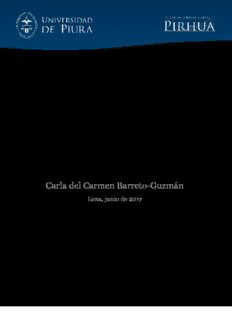
how to develop listening skills in efl adult learners to succeed in their oral communication PDF
Preview how to develop listening skills in efl adult learners to succeed in their oral communication
HOW TO DEVELOP LISTENING SKILLS IN EFL ADULT LEARNERS TO SUCCEED IN THEIR ORAL COMMUNICATION Carla del Carmen Barreto-Guzmán Lima, junio de 2017 FACULTAD DE CIENCIAS DE LA EDUCACIÓN Maestría en Educación con Mención en Enseñanza de Inglés como Lengua Extranjera Barreto, C. (2017). How to Develop Listening Skills in EFL Adult Learners to Succeed in Their Oral Communication (Tesis de maestría en Educación con Mención en Enseñanza de Inglés como Lengua Extranjera). Universidad de Piura. Facultad de Ciencias de la Educación. Lima, Perú. HOW TO DEVELOP LISTENING SKILLS IN EFL ADULT LEARNERS TO SUCCEED IN THEIR ORAL COMMUNICATION Esta obra está bajo una licencia Creative Commons Atribución- NoComercial-SinDerivadas 2.5 Perú Repositorio institucional PIRHUA – Universidad de Piura CARLA DEL CARMEN BARRETO GUZMÁN HOW TO DEVELOP LISTENING SKILLS IN EFL ADULT LEARNERS TO SUCCEED IN THEIR ORAL COMMUNICATION UNIVERSIDAD DE PIURA FACULTAD DE CIENCIAS DE LA EDUCACIÓN LICENCIATURA EN CIENCIAS DE LA EDUCACIÓN MENCIÓN EN ENSEÑANZA DE INGLÉS COMO LENGUA EXTRANJERA 2017 APPROVAL The thesis titled HOW TO DEVELOP LISTENING SKILLS IN EFL ADULT LEARNERS TO SUCCEED IN THEIR ORAL COMMUNICATION presented by CARLA DEL CARMEN BARRETO GUZMÁN in accordance with the requirements of being awarded the Degree of Master in Education with Mention in Teaching English as a Foreign Language, was approved by the Thesis Director Maria Esther Linares and defended on ...................................... before a Jury with the following members: ________________ _______________ President Secretary _______________ Informant ACKNOWLEDGEMENTS Writing this thesis has devoted me endless time, having to spend many hours to it. For this reason, I want to thank my family, my two daughters for their patience, support, and their help in many ways. Also, to my great friends who supported me with my duties in order to have the time to finish this thesis. To my tutor, Mg. Maria Esther Linares, who supported and guided me during this period. She put a lot of pressure being very strict with her corrections with the only target that was to succeed in my thesis. And now I thank her because this made me read more and work harder to become a better teacher and better student. INDEX INTRODUCTION INTRODUCTION ................................................................................... 1 CHAPTER I. INVESTIGATION OUTLINE ....................................... 3 1.1. Formulation of the Problem ............................................................ 3 1.2. Hypothesis .................................................................................... 5 1.2.1. General Hypothesis ................................................................ 5 1.2.2. Specific Hypothesis ............................................................... 5 1.3. Delimitations of the objectives ........................................................ 5 1.3.1. General Objective .................................................................. 5 1.3.2. Specific Objectives ............................................................... 6 1.4. Justification of the investigation ...................................................... 6 1.5. Limitations of the study ................................................................ 8 1.6. Antecedents of the investigation .................................................... 10 CHAPTER II. THEORETICAL FRAMEWORK ............................. 19 2.1. Background of the research............................................................ 19 2.2. Listening ........................................................................................ 22 2.2.1. Listening Skills ..................................................................... 23 2.2.2.1. Types of listening .................................................... 24 2.3. Listening Strategies ........................................................................ 28 2.4. Listening in English Language Teaching (ELT)............................ 29 2.4.1. Metacognitive Strategy ......................................................... 33 2.4.2. Cognitive Strategy ............................................................... 34 2.4.3. Socio Affective Strategy ....................................................... 34 2.5. Oral Communication ...................................................................... 34 2.5.1. Communication ................................................................... 34 2.5.2. Oral Communication ............................................................ 35 2.5.3. Effective Oral Communication ............................................. 36 CHAPTER III. METHODOLOGY OF THE INVESTIGATION ...39 3.1. Investigation Type ..........................................................................39 3.2. Design of the Investigation .............................................................39 3.3. Population and Study Sample ........................................................40 3.3.1. Universe ................................................................................40 3.3.2. Population .............................................................................40 3.3.3. Sample ...................................................................................40 3.4. Variables .........................................................................................40 3.4.1. Independent Variable ...........................................................40 3.4.2. Dependent Variable ...............................................................41 3.5. Techniques and Instruments for Gathering Data ............................42 3.5.1. Instruments for gathering data .............................................42 3.5.1.1. Characteristics of the Ethnography of the sample group ...........................................................42 3.5.1.2. Characteristics of the Age and Gender of the Sample Group .........................................................42 3.5.1.3. Characteristics of the Educational and L2 Learning ackground of the Sample Group. .............43 3.5.1.4. Material Used with the Sample Group ....................43 3.5.2. Description of instruments ....................................................44 3.5.2.1. Pre-Test ....................................................................44 3.5.3. Development of Listening Skills Procedures ........................45 3.5.4. Listening Techniques ............................................................46 3.5.4.1. Listening 1 ................................................................46 3.5.4.2. Listening 2 ...............................................................47 3.5.4.3. Listening 3 ...............................................................48 3.5.4.4. Listening 4 ...............................................................49 3.5.4.5. Post-test ...................................................................49 3.6. Reliability and Validity ..................................................................50 3.6.1. Reliability ..............................................................................50 3.6.2. Validity .................................................................................50 3.6.2.1. Internal Validity ......................................................50 3.6.2.2. External Validity ......................................................51 3.7. Procedures ......................................................................................51 3.7.1. Research Design ...................................................................51 3.7.2. Development of Activities ....................................................52
Description: